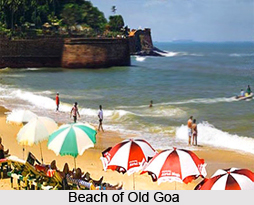 The city of Old Goa was also known as Velha Goa which means `old` in Portuguese. It is registered under the UNESCO World Heritage Site. The city of Old Goa is located in the district of North Goa and 9km away from Panaji, the capital city of the state. It was built during the 15th century by Bijapur Sultanate. The city earlier served as the capital of the Portuguese India from 16th century but was later abandoned by them in the 18th century as a result of the outbreak of plague. They shifted their base to Panjim or Panaji. The city is famous for its magnificent buildings and churches. It was abandoned by the Portuguese officially in 1843 when the capital was moved to.
The city of Old Goa was also known as Velha Goa which means `old` in Portuguese. It is registered under the UNESCO World Heritage Site. The city of Old Goa is located in the district of North Goa and 9km away from Panaji, the capital city of the state. It was built during the 15th century by Bijapur Sultanate. The city earlier served as the capital of the Portuguese India from 16th century but was later abandoned by them in the 18th century as a result of the outbreak of plague. They shifted their base to Panjim or Panaji. The city is famous for its magnificent buildings and churches. It was abandoned by the Portuguese officially in 1843 when the capital was moved to.
History of Old Goa
The city of Old Goa earlier served as a port for the Vijaynagar and Kadamba kings. It was also the second capital of the kingdom Bijapur during the rule of Adil Shah. Shah`s palace and his mosques and temples were earlier built here. Later it was overtaken by the Portuguese rulers who had their administrative seats here. Under their rule the city not only became the Capital of Goa but also became well-known as the "Lisbon of the East." Its population had reached almost 200,000. Afterwards with the outbreak of cholera and malaria the city was left abandoned. Its population also reduced drastically. Due to continue neglect in the coming years the buildings and other constructions began to ruin and at present only a few are in good condition. Today most the buildings are preserved by the archaeological survey of India and the Archdiocese of Goa. The place is considered as holy by the Goans particularly the Goan Christians as it has been the site of the sacred relics of St Francis Xavier or `Goencho Saib.` Velha Goa was incorporated into the Republic of India in 1961, together with the rest of Goa.
Churches of Old Goa
Old Goa has been a famous tourists spot with magnificent buildings, monuments and churches dotting all over. The Portugese had also significantly contributed towards the construction of these buildings. The most important churches in Old Goa can be listed as the Se Cathedral, Church of St. Francis of Assisi, Basilica of Bom Jesus and others.
Tourists Spots in Old Goa
There are several locations in Old Goa which have been major tourist spots. Monuments such as the Viceroy`s Arch, Fort Naroa, Archaeological museum and portrait gallery and others, apart from these monuments, there are few beaches in Old Goa like the Miramar beach, Dona Paula, Bogmalo beaches.



















